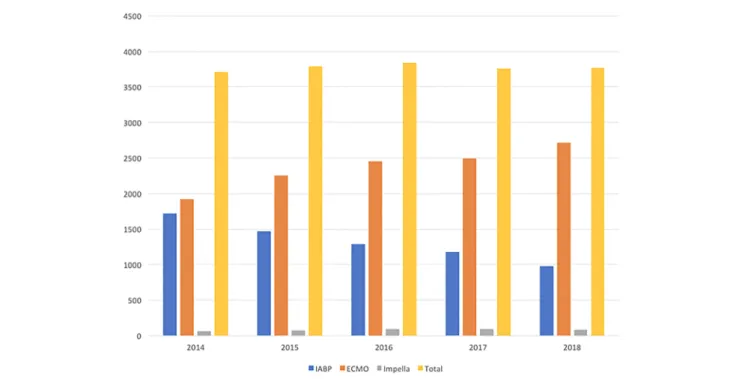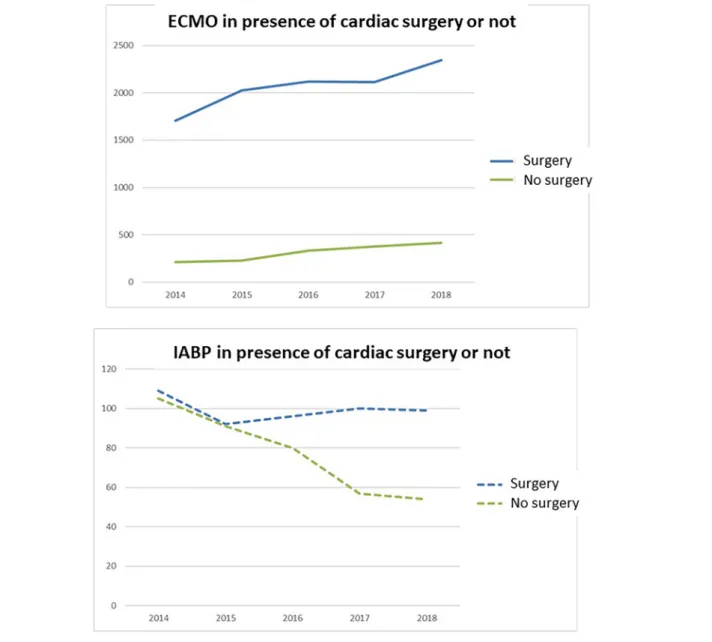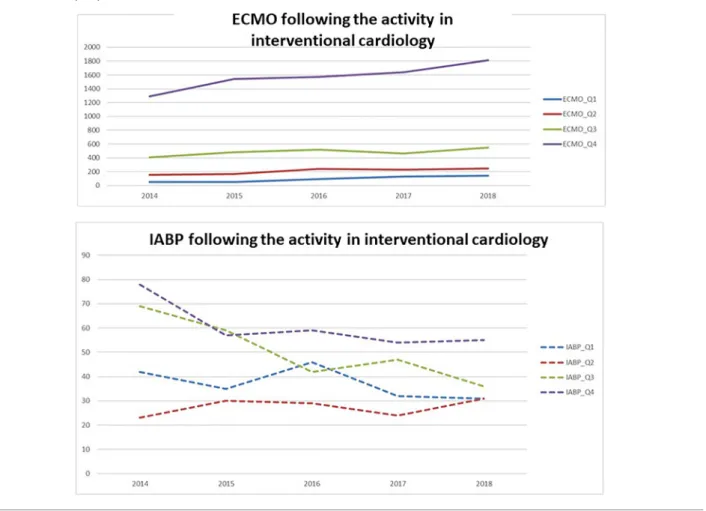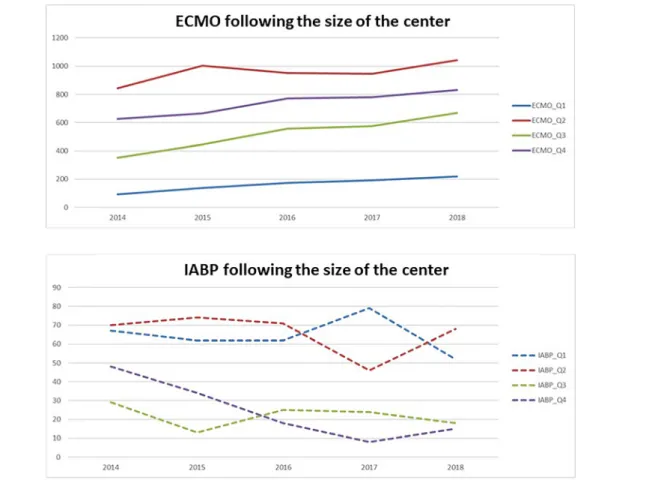HAL Id: hal-02549169
https://hal.archives-ouvertes.fr/hal-02549169
Submitted on 1 Jun 2020
HAL is a multi-disciplinary open access
archive for the deposit and dissemination of
sci-entific research documents, whether they are
pub-lished or not. The documents may come from
teaching and research institutions in France or
abroad, or from public or private research centers.
L’archive ouverte pluridisciplinaire HAL, est
destinée au dépôt et à la diffusion de documents
scientifiques de niveau recherche, publiés ou non,
émanant des établissements d’enseignement et de
recherche français ou étrangers, des laboratoires
publics ou privés.
Distributed under a Creative Commons Attribution - NonCommercial - NoDerivatives| 4.0
International License
Intra-aortic balloon pump: is the technique really
outdated?
Mariama Akodad, Clément Delmas, Laurent Bonello, Claire Duflos, François
Roubille
To cite this version:
Mariama Akodad, Clément Delmas, Laurent Bonello, Claire Duflos, François Roubille. Intra-aortic
balloon pump: is the technique really outdated?. ESC Heart Failure, Wiley, 2020, 7 (3), pp.1025-1030.
�10.1002/ehf2.12721�. �hal-02549169�
Intra-aortic balloon pump: is the technique really
outdated?
Mariama Akodad
1,2, Clément Delmas
3, Laurent Bonello
4, Claire Du
flos
5and François Roubille
1,2*
1Department of Cardiology, Montpellier University Hospital,34295, Montpellier, Cedex 5, France;2PhyMedExp, University of Montpellier, INSERM U1046, CNRS UMR 9214,
34295, Montpellier, Cedex 5, France;3Intensive Cardiac Care Unit, Cardiology Department, University Hospital of Rangueil,31059, Toulouse, France;4Department of
Cardiology, Intensive Care Unit, Aix-Marseille Université, Assistance Publique-Hôpitaux de Marseille, Hôpital Nord, Marseille, France;5Department of Medical Information, Montpellier University Hospital,34295, Montpellier, Cedex 5, France
Abstract
Aims Intra-aortic balloon pump (IABP) utilization was expected to be quickly abandoned following the IABP-shock trial and its class III, level B recommendation in the 2016 European Society of Cardiology (ESC) guidelines. The aim of this study was to evaluate the use of IABP compared with other mechanical support devices in a nationwide approach.
Methods and results We conducted a retrospective study based on the French national hospital discharge database. All patients undergoing assist device implantation by IABP, extracorporeal membrane oxygenation (ECMO), or IMPELLA® from 2014 to 2018 (2 years before/2 years after the 2016 guidelines) were included. The primary endpoint was the incidence of IABP implantation over the years. Secondary endpoints were incidence of total assist device, ECMO, and IMPELLA® implantations. From 2014 to 2018, a total of 18 940 patients benefited from mechanical support by IABP (n = 6657, 35.2%), ECMO (n =11 881, 62.7%), or IMPELLA® (n = 402, 2.1%) in France. The incidence of total mechanical support implantations (ECMO and IABP) was constant over the years. IABP implantations decreased progressively from1725 implantations in 2014 to 996 in2018 ( 42%). By contrast, ECMO implantations increased progressively from 1919 implantations in 2014 to 2763 implanta-tions in2018 (+44%). IMPELLA® implantations remained stable over the years from 63 (1.7%) implantations in 2014 to 83 (2.1%) in2018.
Conclusions In this nationwide real-life study, despite a significant decline in IABP implantations over the years since the ESC guidelines, this device remained used in clinical practice with around1000 implantations in 2018. The size of centres was not strictly correlated with this use, suggesting differential uses depending on the local background.
Keywords Intra-aortic balloon pump (IABP); Mechanical support; Cardiogenic shock; Extracorporeal membrane oxygenation (ECMO)
Received:14 September 2019; Revised: 29 February 2020; Accepted: 31 March 2020
*Correspondence to: François Roubille, Cardiology Department, Hôpital Arnaud de Villeneuve, CHU de Montpellier, UFR de Médecine, Université Montpellier1, 371, avenue du Doyen Gaston Giraud,34295 Montpellier Cedex 05, France. Email: francois.roubille@gmail.com
Introduction
Cardiogenic shock (CS) is still associated with a high rate of mortality (30–50%) despite improvements in therapies.1 In this situation, short-term mechanical support, in addition to vasoactive agents, may improve systemic perfusion allowing cardiac recovery. Among mechanical support, intra-aortic balloon pump (IABP), had been widely used for 50 years especially in acute ischaemic setting.2 However,
the level of recommendation of routine intra-aortic balloon
pump (IABP) in the case of cardiogenic shock (CS) decreased from class I, level C to class III, level B in the 2016 European Society of Cardiology (ESC) guidelines, following the IABP-shock trial, because its efficacy had been questioned.3,4 IABP utilization was then expected to de-crease dramatically.
The aim of this study was to evaluate the utilization of IABP compared with other devices in a nationwide approach. Our hypothesis was a dramatic decrease when comparing2014– 2016/2016–2018.
Methods
We conducted a retrospective study based on the French national hospital discharge database. All patients who underwent assist device implantation by either IABP or extracorporeal membrane oxygenation (ECMO) from 2014 to 2018 (2 years before/2 years after the 2016 guidelines) were included. The primary endpoint was the incidence of IABP implantations over the years. Secondary endpoints were incidence of total assist device implantations and ECMO implantation.
IABP, ECMO, and IMPELLA® are described here despite the underuse of IMPELLA® in France until now because it is not reimbursable. Data concerning clinical characteristics and medical history were not available. To better understand the evolutions of use of these devices, the centres have been divided following (i) the presence or not of cardiac surgery, (ii) the level of activity of interventional cardiology (quartiles), and (iii) the size of centres in terms of beds (quartiles).
The investigation conforms with the principles outlined in the Declaration of Helsinki.
Results
From2014 to 2018, a total of 18 940 patients benefited from mechanical support by IABP (n = 6657, 35.2%), ECMO (n =11 881, 62.7%), or IMPELLA® (n = 402, 2.1%) in France. The proportion of total mechanical support yearly was
constant with 3707 (19.6%) device implantations in 2014, 3792 (20.1%) in 2015, 3838 (20.3%) in 2016, 3761 (19.9%) in2017, and 3842 (20.2%) in 2018.
From 2014 to 2018, incidence of IABP implantations decreased from1725 (46.5% of mechanical support in 2014) to996 (25.9% of mechanical support in 2018) with a 42% of decrease in IABP implantations within this period. Conversely, ECMO implantations increased from 1919 implantations (51.8% of mechanical support) in 2014 to 2715 implantations in2018 (71.9% of mechanical support), with a 42% of increase in ECMO implantations within this period. IMPELLA® implanta-tions remained very low and stable over the years from 63 (1.7%) implantations in 2014 to 83 (2.1%) in 2018 (Figure1).
These evolutions can be described following the size and activities of centres. This increase of ECMO implantations was mainly due to large centres with cardiac surgery (Figure 2). Nevertheless, these centres were users of IABP too. Both centres with high-level activities (Quartiles 3 and 4) or low-level activities (Quartiles 1 and 2) in terms of interven-tional cardiology used IABP (Figure3). However, large centres in terms of beds (Quartiles 3 and 4) presented a strong decrease by contrast with stable IABP use in small-sized or medium-sized centres (Quartiles1 and 2) (Figure4).
Discussion
In this real-life nationwide study, five main results were highlighted:
Figure 1 Incidence of IABP, ECMO, and IMPELLA® implantations yearly. Total IABP, ECMO, and IMPELLA® implantations in 2014, 2015, 2016, 2017, and 2018 in France. ECMO, extracorporeal membrane oxygenation; IABP, intra-aortic balloon pump.
1026 M. Akodad et al.
ESC Heart Failure2020; 7: 1025–1030 DOI:10.1002/ehf2.12721
(1) IABP insertion decreased over the 5 past years but with a still wide utilization despite recent downgrading in ESC guidelines.
(2) Incidence of mechanical support implantations was con-stant yearly as IABP was supplanted by ECMO with a sig-nificant increase in ECMO implantations over the years. (3) This increase was homogeneous in centres independent
of the size of the centres, although ECMO was by far more used in centres with cardiac surgery and/or inter-ventional cardiology.
(4) IABP was by contrast more used in small centres (when considering the numbers of beds but not specifically the interventional cardiology activity).
(5) IMPELLA® was used in a small number of patients, stable over the years.
The decrease in IABP implantations observed referred to the recent downgrading in the ESC guidelines for systematic IABP implantation in cardiogenic shock.3 However, IABP is still widely used with nearly 1000 implantations in 2018 nation-wide for many reasons. First, many centres may have no ac-cess to others mechanical support. IABP remains easy, fast, and safe to place. It can be inserted by a cardiologist, an intensivist, or a surgeon. All these reasons may explain the stability of IABP use in smaller centres in our study where IABP may be the most available mechanical device.
Figure 2 ECMO and IABP implantations according to the presence or not of onsite cardiac surgery. ECMO, extracorporeal membrane oxygenation; IABP, intra-aortic balloon pump.
Second, some indications may be relevant for IABP implan-tation in CS. Indeed, mechanical complications of myocardial infarction such as ventricular septal defect or mitral regurgi-tation are well-known although relatively rare indications for IABP implantation.5,6 Above all, this technique is cost-effective, simple, and feasible in all centres. Moreover, com-plications are rare after IABP in comparison with ECMO.
Importantly, despite decrease in IABP implantation, total mechanical support implantation remained constant over the years. Indeed, ECMO implantations significantly increased over the years. ECMO may offer an appealing support as this technique proved its efficacy in CS,7especially in the case of biventricular dysfunction. However, ECMO is available only in selected“level 3” centres,8limiting its utilization in routine. In our study, ECMO utilization mainly increased in large cen-tres with cardiac surgery that may correspond to those“level 3” centres. Perhaps this stable total use of assist device could reflect the maximal use in large tertiary centres because of limited means.
Alternatively, these devices could be used in different ways depending on the kind/size of centres but also because of the
target. IABP and ECMO are indeed very different in the prin-ciple of function and should therefore have somewhat differ-ent indications and uses (apart from the lately class III recommendation for IABP). There are conditions of pulseless activity in cardiogenic shock, where ECMO could be life-saving while IABP may not suffice. Other assist devices are needed such as a bridge to potential recovery, thus saving the ECMO for more serious situations with completely inade-quate heart pump function. Above all, ECMO is more compli-cated to use than IABP, but its use is expected to have been expanding in the last years because of the need of ECMO in certain circumstances and not necessarily because the alter-native (IABP) is not anymore recommended. On the other hand, IMPELLA® may offer an attractive alternative to IABP. However, because the cost of this device is not reimbursable in France, its utilization is largely limited, totalling around2% of patients in our study and not increasing over the years.
Finally, IABP is used not only by little centres unable to provide ECMO but also by large centres with surgery and high-volume activity, suggesting that other indications re-main (high-risk patients awaiting coronary artery bypass, Figure 3 ECMO and IABP implantations according to the activity in interventional cardiology. The activity in interventional cardiology was divided into four quartiles, whith Q1 as the smaller quartile of activity and Q4 as the most important. ECMO, extracorporeal membrane oxygenation; IABP, intra-aortic balloon pump.
1028 M. Akodad et al.
ESC Heart Failure2020; 7: 1025–1030 DOI:10.1002/ehf2.12721
post-cardiotomy shock, mechanical complications of acute myocardial infarction, temporary assist device after surgery, etc.).
Conclusions
In this nationwide real-life study, despite a significant decline in IABP implantations over the years since the ESC guideline, this device remains widely used in clinical practice with a de-crease in IABP implantations less important than expected. In
other words, the representation of cardiogenic shock and means used to fight this very severe condition appears by far more complex than initially expected, suggesting the need for more detailed studies including real-life registries such as the FRENSHOCK registry (NCT02703038).
Con
flict of interest
None declared.
References
1. Wayangankar SA, Bangalore S, McCoy LA, Jneid H, Latif F, Karrowni W, Charitakis K, Feldman DN, Dakik HA, Mauri L, Peterson ED, Messenger J, Roe M, Mukherjee D, Klein A. Temporal
trends and outcomes of patients
undergoing percutaneous coronary
interventions for cardiogenic shock
in the setting of acute myocardial
infarction: a report from the CathPCI Registry. JACC Cardiovasc Interv 2016;9: 341–351.
2. Kantrowitz A, Tjonneland S, Freed PS, Phillips SJ, Butner AN, Sherman JL Jr.
Initial clinical experience with
intraaortic balloon pumping in
cardiogenic shock. JAMA 1968; 203:
113–118.
Figure 4 ECMO and IABP implantations according to the size of the centre in terms of beds. Centres were divided into four quartiles according to the number of beds, with Q1 as the smaller number of beds and Q4 as the most important number of beds. ECMO, extracorporeal membrane oxygenation; IABP, intra-aortic balloon pump.
3. Ponikowski P, Voors AA, Anker SD, Bueno H, Cleland JGF, Coats AJS, Falk V,
González-Juanatey JR, Harjola V-P,
Jankowska EA, Jessup M, Linde C, Nihoyannopoulos P, Parissis JT, Pieske B, Riley JP, Rosano GMC, Ruilope LM, Ruschitzka F, Rutten FH, van der Meer P, ESC Scientific Document Group. 2016 ESC Guidelines for the diagnosis and treatment of acute and chronic heart fail-ure: The Task Force for the diagnosis and treatment of acute and chronic heart fail-ure of the European Society of Cardiology (ESC)Developed with the special contri-bution of the Heart Failure Association (HFA) of the ESC. Eur Heart J 2016;37: 2129–2200.
4. Thiele H, Zeymer U, Neumann F-J, Ferenc M, Olbrich HG, Hausleiter J, Richardt G,
Hennersdorf M, Empen K, Fuernau G, Desch S, Eitel I, Hambrecht R, Fuhrmann J, Böhm M, Ebelt H, Schneider S, Schuler G, Werdan K, IABP-SHOCK II Trial Investi-gators. IABP-SHOCK II Trial InvestiInvesti-gators. Intraaortic balloon support for myocardial infarction with cardiogenic shock. N Engl J Med 2012;367: 1287–1296.
5. Jannati M, Attar A. Intra-aortic balloon pump postcardiac surgery: a literature re-view. J Res Med Sci 2019;24: 6. 6. Huu AL, Shum-Tim D. Intra-aortic
bal-loon pump: current evidence & future perspectives. Future Cardiol 2018; 14: 319–328.
7. Ouweneel DM, Schotborgh JV, Limpens J, Sjauw KD, Engström AE, Lagrand WK, Cherpanath TGV, Driessen AHG, de Mol BAJM, Henriques JPS. Extracorporeal life
support during cardiac arrest and cardio-genic shock: a systematic review and meta-analysis. Intensive Care Med 2016; 42: 1922–1934.
8. Bonnefoy-Cudraz E, Bueno H, Casella G, de Maria E, Fitzsimons D, Halvorsen S, Hassager C, Iakobishvili Z, Magdy A, Marandi T, Mimoso J, Parkhomenko A, Price S, Rokyta R, Roubille F, Serpytis P,
Shimony A, Stepinska J, Tint D,
Trendafilova E, Tubaro M, Vrints C, Walker D, Zahger D, Zima E, Zukermann R, Lettino M. Editor’s choice—acute car-diovascular care association position pa-per on intensive cardiovascular care units: an update on their definition, struc-ture, organisation and function. Eur Heart J Acute Cardiovasc Care 2018;7: 80–95.
1030 M. Akodad et al.
ESC Heart Failure2020; 7: 1025–1030 DOI:10.1002/ehf2.12721



